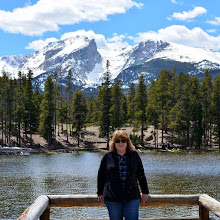We visited a quirky Colorado restaurant and indoor fantasy Mexican-style entertainment center called Casa Bonita in October.
The restaurant was decorated for Halloween at the time, and they even changed their outdoor marquee to say "Casa Boonita"!
Reservations are not easy to get at this very popular restaurant and entertainment center, and we felt fortunate to be able to celebrate our daughter-in-law's birthday together!
On the Casa Bonita Fun Facts page, they say:
"The Greatest Restaurant in the World!
A cultural institution in the Denver area since its opening in 1974, Casa Bonita, under new ownership, is proud to open with a refreshed look and feel, and a brand new culinary team. While maintaining the magical ability to transport guests back in time to 1970s Mexico, Casa Bonita provides an unmatched experience that includes live music, shows, games, and memories that will last a lifetime."
Inside, different facades and themed rooms are intended to invoke regional Mexican architectural styles: for example, Acapulco, Puerto Vallarta, and Guadalajara.
After dinner, one can go to Casa Bonita's theater and see a magic show!
It is also fun to travel on foot through the long, dark Black Bart's Cave and find his stash of gold, but beware of ghouls and detours along the way!
One can also buy tickets to play in the arcade, where you can win prizes!
Admission to the restaurant also enables guests to interact with roaming characters in costume, have their face painted, get a balloon animal creation, make a wish in the wishing well, buy souvenirs in the Mercado, listen to a mariachi band, and watch a puppet show.
The most exciting attraction in Casa Bonita is watching the periodic Cliff Diver Show!
Divers appear on the cliffs while music plays, and then they make a daring twisting dive into the water below!
A video of a cliff dive!
\
There are interesting display cases of Casa Bonita's 50-plus-year history memorabilia in one area of the restaurant.
The Casa Bonita Restaurant concept was originally founded in 1968 in Oklahoma City, OK, by entrepreneur Bill Waugh. It later expanded to Tulsa, OK, Little Rock, AR, Fort Worth, TX, as well as Lakewood, CO, but Colorado's Casa Bonita location is the only location still remaining in business.
In 2021, Trey Parker and Matt Stone, the creators of the popular animated satirical sitcom South Park, shown on Comedy Central, reached an agreement to purchase Casa Bonita’s Lakewood location, which had been closed since early 2020 due to the Covid pandemic and then bankruptcy. Parker and Stone had many memories of going to Casa Bonita as children, and the restaurant meant a great deal to them. They had to invest many millions to refurbish the entire restaurant, and the story about all they faced to reopen Casa Bonita can be seen in the documentary called Casa Bonita Mi Amor.
The South Park character, Cartman. has his own corner in Casa Bonita, and on the day we visited, he was wearing his Halloween costume!
" The iconic, pink Casa Bonita tower stands 85′ tall and is visible for miles. On top of the tower’s golden dome stands a statue of Cuauhtémoc (kwah-hoo-tem’-ok), the last Aztec Emperor.
The exterior of the building was repainted in 2022 and required over 400 gallons of custom-blended pink paint!"
We had a fun time at Casa Bonita--we visited a few times in the past and enjoyed seeing all the improvements on this visit after its refurbishment.
It is wonderful that such a fun, iconic place was saved for future generations to enjoy!
Blogs I link with:
Mosaic Monday, Hello Monday, Through My Lens Monday, Hearth, and Soul Link Party, You Are the Star Blog Hop, Nature Notes, Home Matters Linky Party, Ducks in a Row, Monday Morning Blog Club, Good Random Fun, Tuesdays With A Twist, Talk About It Tuesday, The Happy Now Tuesday, Wordless Wednesday, Wordless Wednesday 2, Wednesday My Corner of the World, Wonderful Wednesday, Thankful Thursday, Little Things Thursday, Thursday Favorite Things, Skywatch Friday, Fantastic Friday, Farmhouse Friday, Crazy Little Lovebirds Friday Link Up, Dare to Share, Saturday Sparks, Saturday Critters,














































